Boat
A boat is a watercraft of a large range of types and sizes, but generally smaller than a ship, which is distinguished by its larger size, shape, cargo or passenger capacity, or its ability to carry boats.
Small boats are typically found on inland waterways such as rivers and lakes, or in protected coastal areas. However, some boats, such as the whaleboat, were intended for use in an offshore environment. In modern naval terms, a boat is a vessel small enough to be carried aboard a ship. Anomalous definitions exist, as lake freighters 1,000 feet (300 m) long on the Great Lakes are called "boats".
Boats vary in proportion and construction methods with their intended purpose, available materials, or local traditions. Canoes have been used since prehistoric times and remain in use throughout the world for transportation, fishing, and sport. Fishing boats vary widely in style partly to match local conditions. Pleasure craft used in recreational boating include ski boats, pontoon boats, and sailboats. House boats may be used for vacationing or long-term residence. Lighters are used to convey cargo to and from large ships unable to get close to shore. Lifeboats have rescue and safety functions.
Boats can be propelled by manpower (e.g. rowboats and paddle boats), wind (e.g. sailboats), and motor (including gasoline, diesel, and electric).
History

Boats have served as transportation since the earliest times.[1] Circumstantial evidence, such as the early settlement of Australia over 40,000 years ago, findings in Crete dated 130,000 years ago,[2] and in Flores dated to 900,000 years ago,[3] suggest that boats have been used since prehistoric times. The earliest boats are thought to have been dugouts,[4] and the oldest boats found by archaeological excavation date from around 7,000–10,000 years ago. The oldest recovered boat in the world, the Pesse canoe, found in the Netherlands, is a dugout made from the hollowed tree trunk of a Pinus sylvestris that was constructed somewhere between 8200 and 7600 BC. This canoe is exhibited in the Drents Museum in Assen, Netherlands.[5][6] Other very old dugout boats have also been recovered.[7][8][9] Rafts have operated for at least 8,000 years.[10] A 7,000-year-old seagoing reed boat has been found in Kuwait.[11] Boats were used between 4000 and 3000 BC in Sumer,[1] ancient Egypt[12] and in the Indian Ocean.[1]
Boats played an important role in the commerce between the Indus Valley Civilization and Mesopotamia.[13] Evidence of varying models of boats has also been discovered at various Indus Valley archaeological sites.[14][15] Uru craft originate in Beypore, a village in south Calicut, Kerala, in southwestern India. This type of mammoth wooden ship was constructed solely of teak, with a transport capacity of 400 tonnes. The ancient Arabs and Greeks used such boats as trading vessels.[16]
The historians Herodotus, Pliny the Elder and Strabo record the use of boats for commerce, travel, and military purposes.[14]
Types
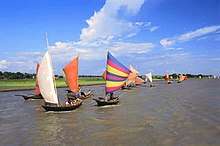
Boats can be categorized into three main types:
Terminology
The hull is the main, and in some cases only, structural component of a boat. It provides both capacity and buoyancy. The keel is a boat's "backbone", a lengthwise structural member to which the perpendicular frames are fixed. On most boats a deck covers the hull, in part or whole. While a ship often has several decks, a boat is unlikely to have more than one. Above the deck are often lifelines connected to stanchions, bulwarks perhaps topped by gunnels, or some combination of the two. A cabin may protrude above the deck forward, aft, along the centerline, or covering much of the length of the boat. Vertical structures dividing the internal spaces are known as bulkheads.
The forward end of a boat is called the bow, the aft end the stern. Facing forward the right side is referred to as starboard and the left side as port.
Building materials
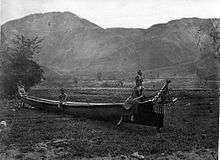
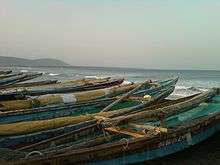
Until the mid-19th century most boats were made of natural materials, primarily wood, although reed, bark and animal skins were also used. Early boats include the bound-reed style of boat seen in Ancient Egypt, the birch bark canoe, the animal hide-covered kayak[17] and coracle and the dugout canoe made from a single log.
By the mid-19th century, many boats had been built with iron or steel frames but still planked in wood. In 1855 ferro-cement boat construction was patented by the French, who coined the name "ferciment". This is a system by which a steel or iron wire framework is built in the shape of a boat's hull and covered over with cement. Reinforced with bulkheads and other internal structure it is strong but heavy, easily repaired, and, if sealed properly, will not leak or corrode.
As the forests of Britain and Europe continued to be over-harvested to supply the keels of larger wooden boats, and the Bessemer process (patented in 1855) cheapened the cost of steel, steel ships and boats began to be more common. By the 1930s boats built entirely of steel from frames to plating were seen replacing wooden boats in many industrial uses and fishing fleets. Private recreational boats of steel remain uncommon. In 1895 WH Mullins produced steel boats of galvanized iron and by 1930 became the world's largest producer of pleasure boats.
Mullins also offered boats in aluminum from 1895 through 1899 and once again in the 1920s,[18] but it wasn't until the mid-20th century that aluminium gained widespread popularity. Though much more expensive than steel, aluminum alloys exist that do not corrode in salt water, allowing a similar load carrying capacity to steel at much less weight.
Around the mid-1960s, boats made of fiberglass (aka "glassfibre") became popular, especially for recreational boats. Fiberglass is also known as "GRP" (glass-reinforced plastic) in the UK, and "FRP" (for fiber-reinforced plastic) in the US. Fiberglass boats are strong, and do not rust, corrode, or rot. Instead, they are susceptible to structural degradation from sunlight and extremes in temperature over their lifespan. Fiberglass structures can be made stiffer with sandwich panels, where the fiberglass encloses a lightweight core such as balsa[19] or foam.
Cold moulding is a modern construction method, using wood as the structural component. In cold moulding very thin strips of wood are layered over a form. Each layer is coated with resin, followed by another directionally alternating layer laid on top. Subsequent layers may be stapled or otherwise mechanically fastened to the previous, or weighted or vacuum bagged to provide compression and stabilization until the resin sets.
Propulsion
The most common means of boat propulsion are as follows:
- Engine
- Inboard motor
- Stern drive (Inboard/outboard)
- Outboard motor
- Paddle wheel
- Water jet (jetboat, personal water craft)
- Fan (hovercraft, air boat)
- Man (rowing, paddling, setting pole etc.)
- Wind (sailing)
Buoyancy
A boat displaces its weight in water, regardless whether it is made of wood, steel, fiberglass, or even concrete. If weight is added to the boat, the volume of the hull drawn below the waterline will increase to keep the balance above and below the surface equal. Boats have a natural or designed level of buoyancy. Exceeding it will cause the boat first to ride lower in the water, second to take on water more readily than when properly loaded, and ultimately, if overloaded by any combination of structure, cargo, and water, sink.
As commercial vessels must be correctly loaded to be safe, and as the sea becomes less buoyant in brackish areas such as the Baltic, the Plimsoll line was introduced to prevent overloading.
European Union classification
Since 1998 all new leisure boats and barges built in Europe between 2.5m and 24m must comply with the EU's Recreational Craft Directive (RCD). The Directive establishes four categories that permit the allowable wind and wave conditions for vessels in each class:[20]
- Class A - the boat may safely navigate any waters.
- Class B - the boat is limited to offshore navigation. (Winds up to Force 8 & waves up to 4 metres)
- Class C - the boat is limited to inshore (coastal) navigation. (Winds up to Force 6 & waves up to 2 metres)
- Class D - the boat is limited to rivers, canals and small lakes. (Winds up to Force 4 & waves up to 0.5 metres)
Gallery
- A boat on the Ganges River
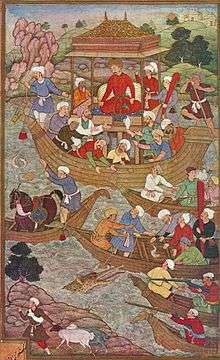 Babur crossing river Son; folio from an illustrated manuscript of ‘Babur-Namah’, Mughal, Akbar Period, AD 1598
Babur crossing river Son; folio from an illustrated manuscript of ‘Babur-Namah’, Mughal, Akbar Period, AD 1598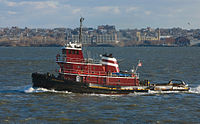
 A ship's derelict lifeboat, built of steel, rusting away in the wetlands of Folly Island, South Carolina, United States
A ship's derelict lifeboat, built of steel, rusting away in the wetlands of Folly Island, South Carolina, United States A boat in an Egyptian tomb, painted around 1450 BC
A boat in an Egyptian tomb, painted around 1450 BC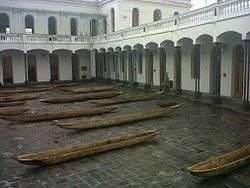 Dugout boats in the courtyard of the Old Military Hospital in the Historic Center of Quito
Dugout boats in the courtyard of the Old Military Hospital in the Historic Center of Quito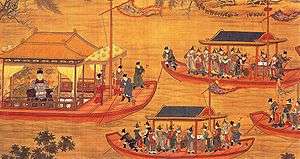 Ming Dynasty Chinese painting of the Wanli Emperor enjoying a boat ride on a river with an entourage of guards and courtiers
Ming Dynasty Chinese painting of the Wanli Emperor enjoying a boat ride on a river with an entourage of guards and courtiers.jpg) Worlds longest dragon boat on display in Phnom Penh, Cambodia
Worlds longest dragon boat on display in Phnom Penh, Cambodia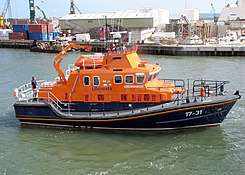 At 17 metres long, the Severn-class lifeboats are the largest operational lifeboats in the UK
At 17 metres long, the Severn-class lifeboats are the largest operational lifeboats in the UK- Aluminum flat-bottomed boats ashore for storage
 A boat shaped like a sauce bottle that was sailed across the Atlantic Ocean by Tom McClean
A boat shaped like a sauce bottle that was sailed across the Atlantic Ocean by Tom McClean- Anchored boats in Portovenere, Italy
 A boat in Utrecht, Netherlands
A boat in Utrecht, Netherlands
See also
- Abora
- Barge
- Cabin cruiser
- Canoe
- Car float
- Dinghy
- Dory
- Fishing vessel
- Flatboat
- Halkett boat
- Inflatable boat
- Kayak
- Launch (boat)
- Lifeboat
- Lighter
- Log canoe
- Narrowboat
- Naval architecture
- Panga (boat)
- Pirogue
- Poveiro
- Rescue craft
- Riverboat
- Rowing
- Sailboat
- Sampan
- Ship
- Ship's boat
- Skiff
- Tour boat
- Traditional fishing boats
- Tûranor PlanetSolar
- Watercraft
- Yacht
References
- Robert A. Denemark, ed. (2000). World system history: The social science of long-term change (1 ed.). London [u.a.]: Routledge. p. 208. ISBN 978-0-415-23276-0.
- "Plakias Survey Finds Mesolithic and Palaeolithic Artifacts on Crete". www.ascsa.edu.gr. Retrieved 2011-10-28.
- First Mariners – Archaeology Magazine Archive. Archive.archaeology.org. Retrieved on 2013-11-16.
- McGrail, Sean (2001). Boats of the World. Oxford, UK: Oxford University Press. p. 11. ISBN 978-0-19-814468-7.
- Van der Heide, G.D. (1974). Scheepsarcheologie in Nederland [Archeology of ships in the Netherlands]. Naarden: Strengholt. p. 507.
- "World's oldest boat". Archived from the original on 2013-05-29. Retrieved 2013-11-08.
- "Oldest Boat Unearthed". China.org.cn. Archived from the original on 2009-01-02. Retrieved 2008-05-05.
- McGrail, Sean (2001). Boats of the World. Oxford, UK: Oxford University Press. p. 431. ISBN 978-0-19-814468-7.
- "8,000-year-old dug out canoe on show in Italy". Stone Pages Archeo News. Retrieved 2008-08-17.
-
Pohjanpalo, Jorma (1970). The sea and man. Translated by Diana Tullberg. New York: Stein and Day. p. 25. ISBN 978-0812813036. Retrieved 2015-11-05.
The oldest raft structures known are at least 8,000 years old.
- Lawler, Andrew (June 7, 2002). "Report of Oldest Boat Hints at Early Trade Routes". Science. 296 (5574): 1791–1792. doi:10.1126/science.296.5574.1791. PMID 12052936. Retrieved 2008-05-05.
- McGrail, Sean (2001). Boats of the World. Oxford, UK: Oxford University Press. pp. 17–18. ISBN 978-0-19-814468-7.
- McGrail, Seán (2004). Boats of the world: From the Stone Age to medieval times (Paperback ed.). Oxford: Oxford University Press. p. 251. ISBN 978-0-19-927186-3.
- McGrail, Seán (2004). Boats of the world : From the Stone Age to medieval times (Paperback ed.). Oxford: Oxford University Press. pp. 50–51. ISBN 978-0-19-927186-3.
- "Beypore History – The Dhows of Beypore". historicalleys.blogspot.com. 6 February 2009.
- Holmes, George C (2016-03-09). Ancient and Modern Ships – Part I. Wooden Sailing-Ships. ISBN 9781473360624.
- Streever, Bill (2009). Cold: Adventures in the World's Frozen Places. New York: Little, Brown and Company. p. 154.
- WH Mullins boat history, Salem Ohio
- .. as in the Iroqois catamaran
- "The Barge Buyer's Handbook" - DBA publications ISBN 9780953281954
External links
| Wikimedia Commons has media related to Boat. |
| Wikiquote has quotations related to: Boats |
| Look up boat in Wiktionary, the free dictionary. |
- University of Washington Libraries Digital Collections – Freshwater and Marine Image Bank, (enter search term "vessels" for images of boats and vessels.)